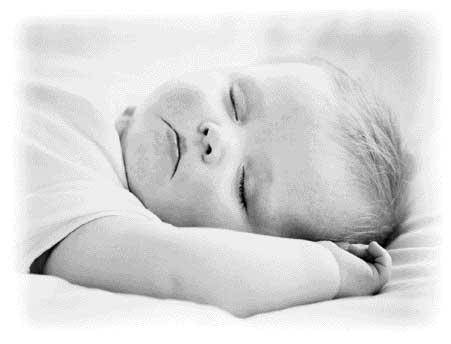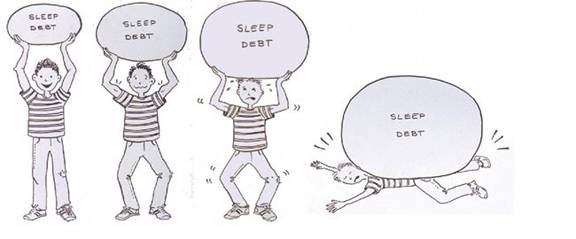Different stages of sleep
Sleep is categorized as Non-REM or REM
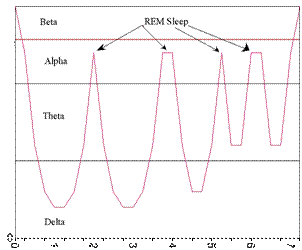
Sleep is categorized into Non-REM sleep (stages one, two, three and four) and REM sleep (dreaming period).
The sleep stage experienced is identified by the sleeper’s brain wave amplitude and frequency – which can be measured with an EEG machine.
Brain frequency ranges
- Alpha- “Awake and relaxed”
- Delta- “Deep sleep”-very slow waves (very low frequency)
- Theta- “Deep sleep”-high amplitude, slow waves (low frequency)
- Beta- REM and “Awake”- has high frequency, during which brain is quite active
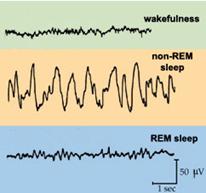
Non-REM sleep (slow frequency, high amplitude brain waves)
“An idling brain in a moving body”
– William Dement, sleep researcher
Stage 1 – Drowsiness – alpha/theta
Transition between sleep and wakefulness lasts just 5-10 minutes before moving to next stage. Eyes begin to roll slowly under the eyelids, and muscle activity slows down. You can be easily awakened.
Stage 2 – Light Sleep – theta/spindles/k-complexes
Eye movements stop, heart rate slows, and body temperature decreases
Peaks of brain waves become higher and higher (sleep spindles) Followed by peaks that suddenly drastically descend and then pick back up (k-complexes); again only lasts a few minutes.

Stages 3 & 4 – Deep Sleep – delta/theta
It is difficult to be awakened. When you are, you do not adjust immediately and often feel groggy and disoriented for several minutes after.
Children may experience bedwetting, night terrors, or sleepwalking
REM / Dream Sleep - beta frequency (High-frequency, low amplitude brain waves)
“An active, hallucinating brain in a paralyzed body”
– William Dement, sleep researcher
At about 70 to 90 minutes into your sleep cycle, you enter REM sleep
Non-motor parts become active. Frequent bursts of your eyes jerking rapidly in various directions under your eyelids, with occasional muscle twitches. Heart may beat faster, breathing may become shallow and rapid, also blood pressure rises;
Thankfully however, apart from the muscles of the heart, lungs, eye and inner ear (see note below on penis*), most of the rest of the body is paralysed (by the release of amino acid glycine from the brain stem onto the motor neurons). Presumeably to prevent us from acting out our dreams, since the most vivid dreaming occurs during this stage.The brain highly values REM sleep.You usually have 3-5 REM episodes per night, and as the night progresses, the length of REM sleep increases, even up to an hour. More recent research has shown that less intense dreams can occur during any of the sleep stages. Although dreaming is associated with REM sleep, 5-10% of people woken during NON-REM say they were dreaming (75-95% say they were dreaming when woken during REM sleep).
* The penis is moved by being filled with blood, not by muscles. The reason why men sometimes wake up with an erection is simply because they were having a dream when they woke up, not because of any erotic thoughts. REM sleep will cause an erection in a non-impotent man no matter what his dream is about – even newborn boys have erections during REM sleep.
Duration of sleep stages
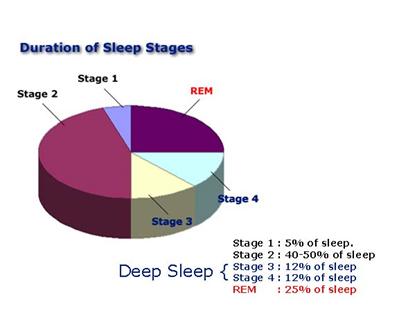
Chart of Summation of Sleep Stages | |||||
| Stage | % spent during sleep | Frequency (cycles per second) | Amplitude (microvolts) | Brain Wave type | Comment |
| Awake | N/A | >12 | beta | ||
| Awake (Relaxed) | N/A | 8-12 | alpha | ||
| REM (Dreaming) | 25% | >12 | beta | Increases as night progresses | |
| Stage 1 (Drowsy) | 5% | 4-8 | 50-100 | alpha, theta | |
| Stage 2 (Light sleep) | 40-50% | 8-15 | 50-150 | theta, spindles, & K-complexes | |
| Stage 3 (Deep sleep) | 12% | 2-4 | 100-150 | delta & theta | Earlier in the night |
| Stage 4 (Deep sleep) | 12% | .5-2 | 100-200 | delta & theta | |
Brain wave patterns
The brain follows patterns of brain wave cycles during sleep
– Each of these cycles last between 90 – 100 minutes each. Repeating 4 or 5 times in one night.
– Everybody has the same pattern of sleep
The sleep cycle
– Begins with 4 stages of slow wave sleep (SWS). Also called Non-REM sleep stages one, two, three, then four.
– Then the stages quickly reverse reaching REM sleep (dreaming).
– The cycle then starts over. As the cycles continue during the night, there is less deep sleep (stages 3 and 4) and more dreaming (REM sleep).
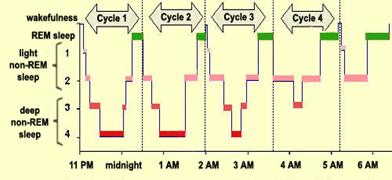
Physiological Differences between Non-REM, REM and awake | |||
| Non-REM (Rest) | REM (associated with dreaming) | Awake | |
| EEG | Low frequency /high amplitude; extensive synchronization of neural activity | High frequency/low amplitude with PGO spikes | High frequency/low amplitude |
| Sensations | Completely absent or very attenuated | Vivid / originate internally | Vivid/originate in external environment |
| Motor Activity | Involuntary/occasional | Paralyzed – except for cardiac and resp. muscles, small muscles of middle ear, and rapid eye movements, brain’s commands to move muscles are blocked. | Voluntary/almost constant |
| Eye movements | Rare | Frequent | |
| Thought | Repetitive | Bizarre / illogical | Linear/ logical |
| Metabolism | PNS predominant/ metabolism slows; temp, heart rate, resp. rate kidney function all reduced; Slow waves = brain resting | Brain’s oxygen (reflects energy) consumption higher than when awake thinking about complex problem; body’s core temp tends to match surrounding temp.; heart/resp. rates increase irregularly; penis erects/clitoris engorges independent of erotic dream. | |
Comparison of Physiological Changes During Non-REM and REM Sleep | ||
| Physiological Process | During Non-REM | During REM |
| Brain activity | Decreases from wakefulness | Increases in motor and sensory areas, while other areas are similar to NREM |
| Heart rate | Slows from wakefulness | Increases and varies compared with NREM |
| Blood pressure | Decreases from wakefulness | Increases (up to 30 percent) and varies from NREM |
| Blood flow to brain | Does not change from wakefulness in most regions | Increases by 50 to 200 percent from NREM, depending on brain region |
| Respiration | Decreases from wakefulness | Increases and varies from NREM, but may show brief stoppages (apnea); coughing suppressed |
| Airway resistance | Increases from wakefulness | Increases and varies from wakefulness |
| Body temperature | Regulated at lower set point than wakefulness; shivering initiated at lower temperature than during wakefulness | Not regulated; no shivering or sweating; temperature drifts toward that of the local environment |
| Sexual arousal | Occurs infrequently | Increases from NREM (in both males and females) |
| Renal system | Kidney filtration, plasma flow, and the excretion of sodium, chloride, potassium, and calcium all are reduced during both NREM and REM sleep. These changes cause urine to be more concentrated during sleep. | |
| Alimentary activity | In a person with normal digestive function, gastric acid secretion is reduced during sleep. In those with an active ulcer, gastric acid secretion is actually increased. In addition, swallowing occurs less frequently. | |
| Endocrine system. | Most hormone secretion is controlled by the circadian clock or in response to physical events. Sleep is one of the events that modify the timing of secretion for certain hormones. Many hormones are secreted into the blood during sleep. E.g. It is believed that the release of growth hormone is partly related to repair processes that occur during sleep. Follicle stimulating hormoneand luteinizing hormone, which are involved in maturational and reproductive processes, are among the hormones released during sleep. In fact, the sleep-dependent release of LH is thought to be the event that initiates puberty. Other hormones, such as thyroid-stimulating hormone, are released prior to sleep. | |
Awakenings in the night
Brief awakenings. At the end of REM sleep that closes each cycle, there is a moment when it is very easy to wake up and people very often do so, generally for < 3 minutes, when often all they do is change body position. The next cycle then begins.
However, with an overstimulated brain, it can take an entire cycle to fall asleep again. These periods of being awake are longer and more common after the first two cycles of sleep have been completed. Hence why so many people find themselves awake from about 4:00 AM to 6:00 AM, after which they finally succeed in falling back into a deep sleep.
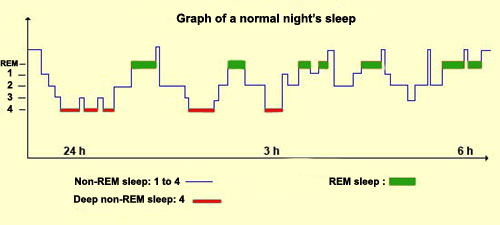
Deep sleep occurs early on in the night. The first two sleep cycles include almost all of the deep non-REM sleep obtained in the course of the night.
More light non-REM and REM sleep later in the night. Periods of REM sleep can last from 30 – 50 minutes. However, we still seem to need at least 30 minutes of non-REM(slow wave) sleep between periods of REM sleep.
Sleep patterns change with age
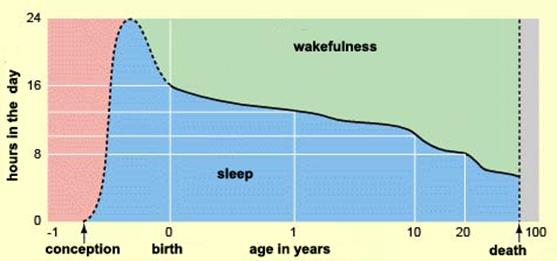
Amount of REM sleep decreases with age. Percentage of REM sleep stabilizes at ~20 – 25% at about age 10. After age 60, this percentage declines significantly, until at age 70, people get only about 45 minutes of REM sleep per night.
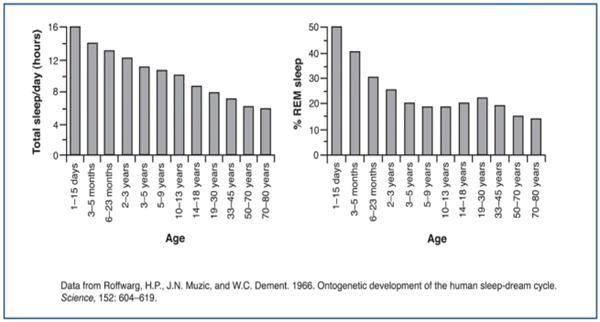
Babies’ high amount of REM sleep develops CNS. Neural activity during REM known to assist developing synapses to find their targets, which accounts for why infants spend about half of their sleeping lives in REM sleep, double the proportion for adults.


















